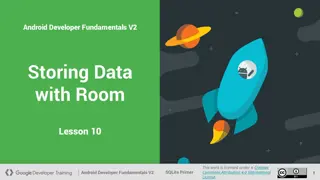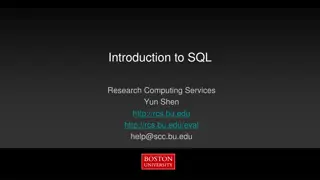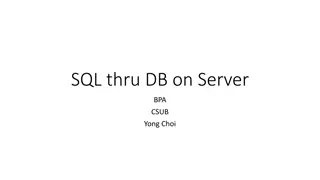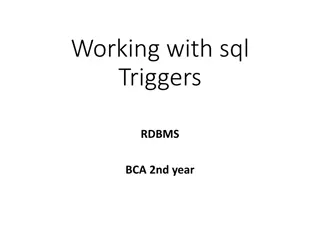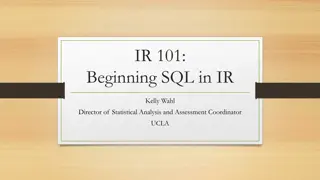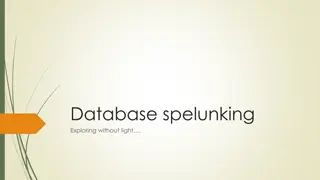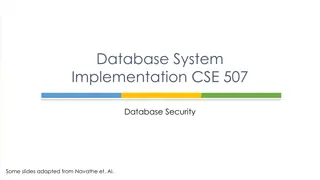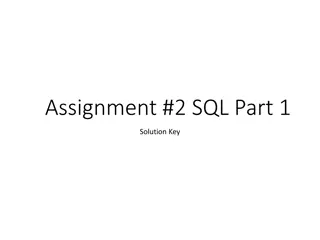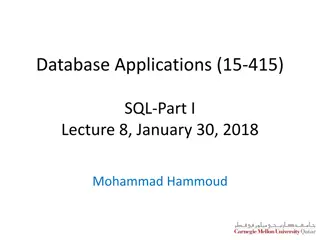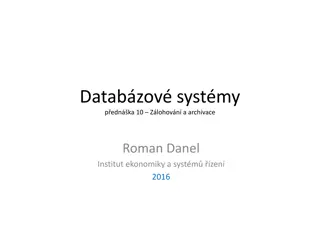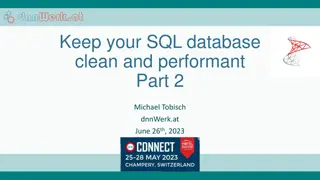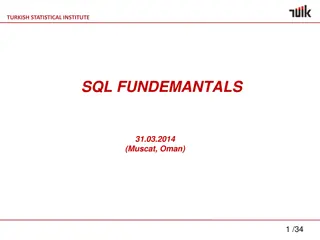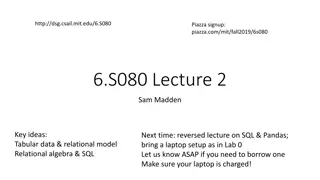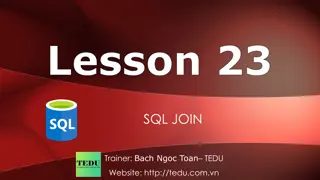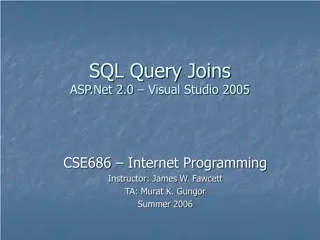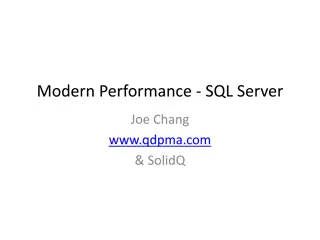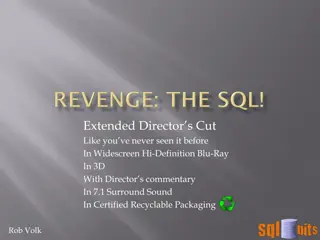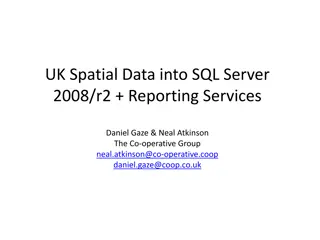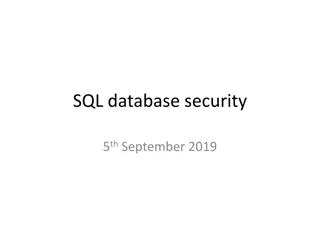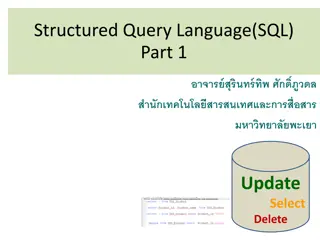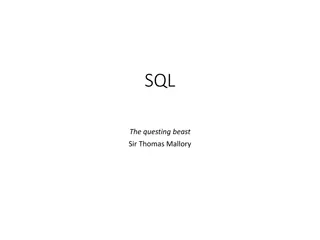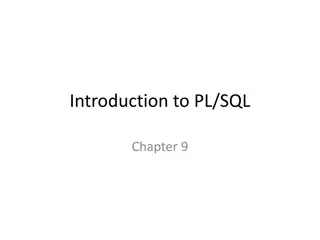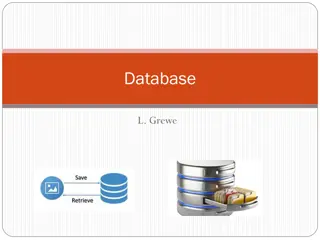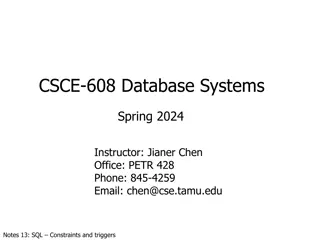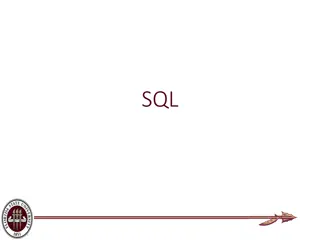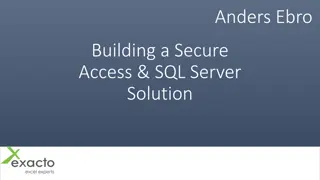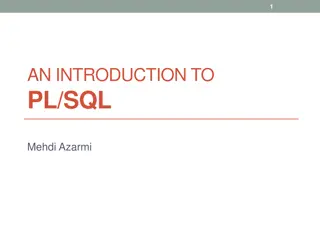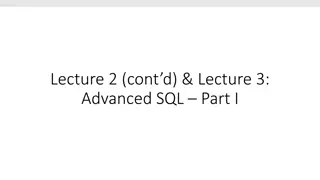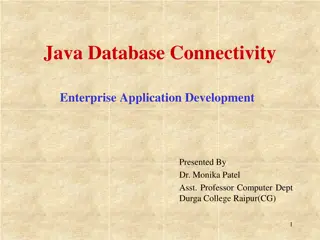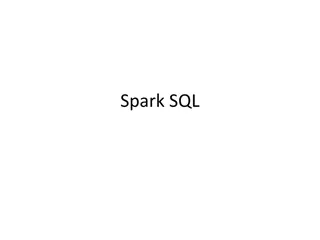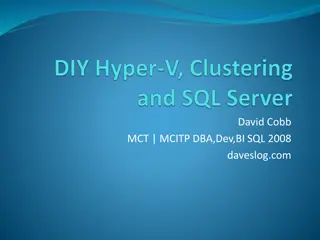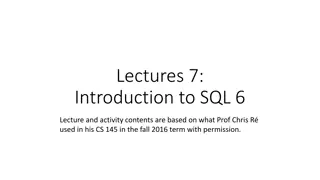SQLite and Data Storage with Room in Android Development
SQLite is a self-contained, serverless, and zero-configuration SQL database engine used in Android development. This primer covers how data is stored in tables, columns, and rows, and provides a refresher on SQL databases, assuming familiarity with SQL query language. Room library simplifies SQLite
2 views • 26 slides
Learn SQL Basics: History, Syntax, and Terminology
SQL (Structured Query Language) is a specialized domain-specific language for managing structured data in relational databases. Developed in the 1970s, it follows a rigid syntax and structure, with specific features like triggers and stored procedures. Understanding SQL history, terminology, and syn
1 views • 38 slides
SQL Queries for Database Management
Explore a series of SQL queries for efficient database management, including selecting specific records, sorting data, and counting customers by country. Enhance your SQL skills with these practical examples showcasing various query types and techniques.
1 views • 10 slides
SQL Triggers in Relational Databases
SQL triggers are stored procedures that are automatically invoked when certain events occur in a database, such as insertions or updates to tables. This article explains the definition of triggers, their syntax, types, and examples of DML triggers in SQL servers. It also covers the concept of row-le
5 views • 19 slides
Database Design Process and Concepts
This lecture on designing databases covers the database design process, normalization, transforming E-R diagrams, physical database design concepts, and steps in logical database modeling. It highlights the importance of logical and physical database design in system development, providing insights
1 views • 64 slides
Introduction to SQL: Learn the Basics and Beyond
Explore the world of Structured Query Language (SQL) with this comprehensive guide. Discover what SQL is, its history, usage, and how to learn it on your own through free online tutorials. Understand the properties of relational databases and get insights into designing a relational database. With S
0 views • 29 slides
Mastering SQL Server: Tips and Tricks for Efficient Database Exploration
Delve into the world of SQL Server with expert tips on finding instances, listing databases, and searching for tables or columns by name. Discover efficient ways to navigate relational databases using SQL queries, PowerShell, and Management Studio, making database exploration a breeze.
0 views • 14 slides
Database Security Measures and Controls
Database security is crucial to protect against threats like loss of integrity, availability, and confidentiality. Countermeasures such as access control, inference control, flow control, and encryption are important for safeguarding databases. Access control involves creating user accounts and pass
1 views • 35 slides
SQL Query Solutions for Film Database
In this SQL solution key, various queries have been provided for a film database. It covers selecting titles and lengths of films rated PG and longer than 180 minutes, finding the average rental rate for each movie rating, counting PG movies mentioning "documentary" in their description, identifying
2 views • 13 slides
Introduction to Database Systems and SQL Programming
Understanding database systems is crucial in today's digital world. Explore the basics of database systems, SQL statements, and Java Database Connectivity (JDBC) in this comprehensive overview. Learn about DBMS, SQL querying, JDBC API, and more to enhance your understanding of managing and interacti
10 views • 24 slides
SQL: Major Aspects and Functionality in Database Applications
SQL, as a relational database language, offers Data Manipulation Language (DML) and Data Definition Language (DDL) for querying and modifying data. Additionally, SQL encompasses triggers, embedded code execution, remote database access, transaction management, and security features for efficient dat
1 views • 52 slides
SQL Functions for Database Queries
SQL functions are essential elements in performing actions and obtaining results in a database query. They come in two main types: scalar functions and aggregate functions. Scalar functions operate on single values, while aggregate functions operate on sets of data. Examples of SQL functions include
1 views • 14 slides
Comprehensive Overview of SQL Commands and Language Categories
In this detailed guide, you will learn about Structured Query Language (SQL) including its various commands such as Data Definition Language (DDL), Data Manipulation Language (DML), Data Control Language (DCL), and Transaction Control Language (TCL). Explore how SQL is used in Database Management Sy
0 views • 15 slides
SQL Server Database Recovery Models and Backup Strategies
Explore the intricacies of SQL Server database recovery models including SIMPLE, BULK-LOGGED, and FULL, along with backup techniques such as full database backups, transaction log backups, and differential backups. Learn about database states, mirror states, and various system databases in SQL Serve
2 views • 24 slides
Efficient SQL Database Maintenance for Performance
Learn to effectively clean and optimize your SQL database for optimal performance. Discover tools like Ola Hallengren's Maintenance Solution and Brent Ozar's First Responder Kit, along with best practices for backup, restore, index optimization, and database integrity checks. Ensure a healthy databa
0 views • 17 slides
Turkish Statistical Institute SQL Fundamentals Overview
The Turkish Statistical Institute provides an in-depth look at SQL fundamentals covering main categories, basic SQL commands, set operations, aggregate functions, join operations, and more. SQL, or Structured Query Language, is a special-purpose programming language designed for managing data in RDB
0 views • 33 slides
SQL Part II Lecture Summary: Nested Queries, Joins, and Updates for Database Applications
In this SQL lecture, Mohammad Hammoud covers nested queries, insertion, deletion, updates, handling NULL values, join variants, and advanced query techniques. Examples include finding sailors who have reserved specific boats, using nested queries to filter data, and deep nested queries for complex d
0 views • 53 slides
Introduction to Tabular Data Modeling and SQL Concepts
Explore the fundamentals of tabular data modeling, relational algebra, SQL, and database relationships through practical examples. Learn about key concepts such as primary keys, tuples, and different types of relationships in database management. Get hands-on experience using Pandas and SQL for data
1 views • 30 slides
Database Basics for ASP.NET Development
Explore the fundamentals of databases, SQL usage, database relationships, and available tools for managing database objects in ASP.NET projects. Learn about relational databases, popular database options like Microsoft SQL Server, and setting up SQL Express for local development.
1 views • 27 slides
SQL JOIN: A Comprehensive Guide
SQL JOIN allows you to merge data from multiple tables in a database, enabling you to access information more efficiently. This comprehensive guide covers the types of JOIN operations available in SQL, such as INNER JOIN, LEFT JOIN, RIGHT JOIN, and FULL JOIN, along with their purposes and practical
0 views • 6 slides
SQL Joins in ASP.Net 2.0 with Visual Studio 2005
Exploring the importance of query joins in SQL, this instructional content delves into inner, outer, left outer, and right outer joins for integrating data from multiple database tables in ASP.Net 2.0. Detailed guidance is provided on setting up SQL databases in Visual Studio .NET 2005, creating tab
0 views • 11 slides
Modern Performance in SQL Server
Explore the evolution of performance in SQL Server with insights from Joe Chang, a seasoned SQL Server consultant. Delve into topics like query optimization, execution plans, CPU and memory advancements, storage technologies, and the significance of performance in today's data environment. Discover
0 views • 40 slides
The World of Azure Database Offerings
Exploring Azure's database offerings including Azure Cosmos DB and Azure SQL Database. Azure Cosmos DB provides a globally scalable document database solution, while Azure SQL Database is a great option for SQL Server workloads. Both platforms offer unique features such as low latency, scalability,
1 views • 15 slides
Unorthodox SQL Techniques Unleashed: REVENGE: The SQL
Explore the unconventional realm of SQL with Rob Volk as he delves into extreme methodologies for manipulating data. From revenge-driven practices to extreme server admin tricks, this session is a wild ride through unparalleled SQL strategies.
0 views • 16 slides
Utilizing UK Spatial Data in SQL Server 2008 R2 Reporting Services
Explore how to display UK geospatial data in SQL Server 2008 R2 Reporting Services by finding and importing Ordnance Survey Open Data. Learn how to represent the UK on a map, import data into SQL, and create example reports. Discover limitations and resources to kickstart your spatial data journey i
0 views • 7 slides
SQL Database Security Best Practices
Understanding SQL database security is crucial for protecting your web service from vulnerabilities. This article covers topics such as access control, injection attacks, privileges management, and best practices for securing your SQL server effectively.
0 views • 16 slides
Comprehensive Overview of SQL: Commands and Categories
Explore the world of Structured Query Language (SQL) through this detailed guide covering SQL categories, command classifications (DDL, DML, DCL, TCL), data manipulation and control languages, and transaction control language. Learn about creating, altering, and dropping database objects, data retri
0 views • 14 slides
SQL: A Comprehensive Guide to Database Querying and Management
SQL, a widely utilized database language, is essential for data management and querying. It offers a complete set of commands for data definition, manipulation, and maintenance, making it a vital skill in today's tech industry. Learn about data types, constraints, and check constraints in SQL, along
0 views • 72 slides
PL/SQL Benefits and Objectives
Explore the advantages of PL/SQL such as integration of procedural constructs with SQL, improved performance, and efficient exception handling. Learn about the objectives of PL/SQL, types of PL/SQL blocks, and using Oracle SQL Developer for development. Gain insights into the structure of PL/SQL blo
0 views • 42 slides
Database Management Systems and Data Storage
Explore the world of Database Management Systems (DBMS) and learn about the evolution of data storage from flat-file to relational databases. Discover the key features of a DBMS, different database types, administration tools, SQL and NoSQL databases, CAP theory, and considerations for choosing betw
1 views • 32 slides
SQL Constraints and Triggers in Database Systems
SQL (Structured Query Language) provides a high-level approach to database management by focusing on what needs to be done rather than how. Constraints and triggers play vital roles in ensuring data integrity and enforcing specific actions. Keys, foreign keys, value-based constraints, tuple-based co
0 views • 130 slides
Database Transactions in SQL
Database transactions in SQL ensure data integrity and consistency by allowing users to group SQL commands into atomic units that can be committed or rolled back as needed. Learn about the ACID properties of transactions, autocommit mode, and how to create and manage transactions effectively.
1 views • 29 slides
SQL - Introduction and Basics
SQL (Structured Query Language) is a standard language for querying and manipulating data. It includes Data Definition Language (DDL) for creating, altering, and deleting tables, Data Manipulation Language (DML) for querying tables and modifying data, and more. Tables in SQL consist of attributes li
0 views • 30 slides
Building a Secure Access & SQL Server Solution with Anders Ebro
Anders Ebro, a Principal consultant with Exacto A/S, shares insights on building a secure access and SQL server solution. With a background in SQL development and experience in managing sensitive data, Anders emphasizes the importance of security aspects such as limiting access to sensitive data, ro
0 views • 20 slides
Introduction to PL/SQL: Oracle's Procedural Language Extension
PL/SQL is Oracle's extension to SQL, combining the power of SQL with the procedural constructs of a 3GL. This introduction covers the basics of PL/SQL blocks, block structure, variables and types, executable sections, and example variable declarations. It also highlights the features such as error h
1 views • 29 slides
Advanced SQL Concepts and Queries Overview
Today's lecture highlights advanced SQL topics such as multi-table queries, set operators, joins, primary keys, foreign keys, and more. The session covers practical activities and fundamental concepts in database management. Explore the nuances of SQL semantics and understand the importance of keys
0 views • 55 slides
Introduction to Java Database Connectivity (JDBC) in Enterprise Application Development
JDBC, or Java Database Connectivity, is a vital technology in enterprise application development that provides a standardized library for Java programs to connect to databases via SQL commands. It abstracts vendor-specific details, making connectivity to multiple databases seamless. JDBC API standar
1 views • 13 slides
Evolution of Database Systems: A Spark SQL Perspective
Explore the evolution of database systems, specifically focusing on Spark SQL, NoSQL, and column stores for OLAP. Learn about the history of parallel DB systems, common complaints, the story of NoSQL, and the advantages of column stores for data aggregation and compression in OLAP scenarios.
0 views • 25 slides
Active/Active SQL Clusters for High Availability
Discover the importance of Active/Active SQL clusters for ensuring 24/7 availability of your database servers. Learn about the benefits, setup process, and the high availability solution it offers for the entire server instance. Follow a detailed step-by-step guide for setting up SQL Active/Active c
1 views • 18 slides
SQL Concepts: Quantifiers, NULLs, and Handling Null Values
Dive into the world of SQL with this content, covering essential concepts such as quantifiers, NULLs, and how SQL handles null values. Explore topics like existential and universal quantifiers, handling NULL values in numerical and boolean operations, and understanding the behavior of NULL values in
0 views • 18 slides
